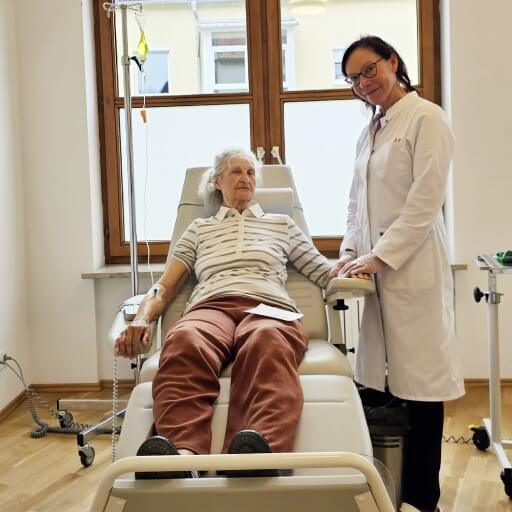تؤثر نقائل الرئة على 20-54٪ من المرضى المصابين بسرطان خارج الصدر، مما يُقلل بشكلٍ كبير من معدلات البقاء على قيد الحياة – تنخفض معدلات البقاء على قيد الحياة لسرطان الثدي من 96٪ إلى 21٪ مع انتشاره في الرئة، بينما تنخفض معدلات البقاء على قيد الحياة لسرطان القولون والمستقيم من 91٪ إلى أقل من 10٪ مع النقائل. تُمثل هذه الأورام الثانوية، والتي تنشأ عادةً من أورام الثدي، وأورام القولون والمستقيم، وأورام البروستاتا، تحديات تشخيصية بسبب عدم وجود أعراض محددة أو غيابها حتى المراحل المتقدمة. على الرغم من هذه العقبات، فإن طرق العلاج المبتكرة مثل TACE والعلاج بالخلايا المتغصنة Dendritic cell therapy تُقدم الآن للمرضى أملاً جديداً، حيث تستهدف الخلايا الخبيثة بشكل فعال مع الحفاظ على وظائف الرئة وتحسين جودة الحياة والتوقعات بشكلٍ كبير.
ما هي نقائل الرئة؟
تحدث نقائل الرئة عندما تنتشر الخلايا السرطانية من الورم الأولي في مكان آخر من الجسم إلى الرئتين. في الواقع، الرئة هي الموقع الثاني الأكثر شيوعاً للانتشار النقيلي.
عندما ينتشر السرطان إلى الرئتين، فإنه يخلق تحدي علاجي معقد يتطلب رعاية متخصصة من طبيب الأورام. يجب أن تخضع الخلايا السرطانية لتحولات متعددة حتى تنتشر بنجاح: الانفصال عن الورم الأصلي، ودخول مجرى الدم أو الجهاز اللمفاوي، والبقاء على قيد الحياة أثناء المرور عبر الجسم، وتثبيت نفسها في أنسجة الرئة، وإنشاء إمداد جديد بالدم.
الرئتان معرضتان بشكلٍ خاص للنقائل لأنها تستقبل كامل الناتج القلبي كل دقيقة، وتحتوي على شبكة الشعيرات الدموية الأكثر كثافة في الجسم، وتوفر بيئة غنية بالأكسجين مثالية لنمو الخلايا السرطانية.
الأورام الأولية التي تؤدي إلى نقائل الرئة
تنتشر عدة أنواع من السرطان بشكل متكرر إلى الرئتين بسبب طبيعتها البيولوجية وأنماط الأوعية الدموية:
- سرطان الثدي. أحد أكثر مصادر نقائل الرئة شيوعاً، وخاصةً في المراحل المتقدمة.
- سرطان القولون والمستقيم. لديه ميل قوي للانتشار إلى الرئتين من خلال نظام الوريد البابي.
- سرطان البروستاتا والخصية. قد تتطور نقائل الرئة في المراحل المتأخرة من تقدُم المرض.
- الساركوما. تُظهر تقارباً خاصاً لأنسجة الرئة، مع ما يصل إلى 80٪ من الحالات النقيلية التي تنطوي على الرئتين.
- سرطان الغدة الدرقية. الأنواع الحليمية والجريبية يمكن أن تنتشر بشكلٍ خاص إلى الرئتين.
- سرطان الكلى. غالباً ما يتجاوز الأعضاء الأخرى لينتشر مباشرةً إلى الرئتين.
- الورم الميلانيني (الميلانوما). معروفه بانتشارها العدواني إلى أعضاء متعددة بما في ذلك الرئتين.
- سرطان البنكرياس. ينتشر في كثير من الأحيان إلى الرئتين جنباً إلى جنب مع الكبد.
- سرطان المثانة. قد ينتشر إلى الرئتين في مراحل متقدمة.
- الورم الأرومي العصبي وورم ويلمز. سرطانات الأطفال ذات معدلات الانتشار الرئوية العالية.
آلية انتشار الورم إلى الرئتين
تُعتبر الرئتان معرضتين بشكل فريد للإصابة بالنقائل بسبب خصائصهما الفسيولوجية. حيث تستقبل الرئة كامل الناتج القلبي كل دقيقة، وتحتوي على شبكة الشعيرات الدموية الأكثف في الجسم، وتتميز بأغشية دقيقة تحبس خلايا الورم المنتشرة بسهولة.
لكي يحدث الانتشار، يجب أن تنفصل الخلايا السرطانية عن الورم الأساسي، وتدخل مجرى الدم (طريقة الانتشار دموية المنشأ)، وتنجو من الدورة الدموية، وتلتصق بالأوعية الدموية الرئوية، وتؤسس نمواً في هذه البيئة الجديدة. تلعب عوامل المُضيف مثل جزيئات التصاق الخلايا، وعوامل النمو، والسيتوكينات أدواراً حاسمة في هذه العملية، وغالباً ما تؤدي إلى حدوث التهاب عندما يستجيب الجسم لهذه الخلايا الغازية.
يناقش الباحثون ما إذا كان الانتشار النقيلي يحدث متأخراً بعد حدوث تغيرات جينية محددة (نظرية فيدلر) أو مبكراً مع بقاء الخلايا في حالة سُبات حتى يتم تحفيزها بواسطة عوامل بيئية (نظرية مورجان). قد تحدث كلتا الآليتين في أنواع مختلفة من الأورام، مما يساهم في الطبيعة المعقدة لعلاج النقائل الرئوية.
أعراض وتشخيص نقائل الرئة
أحد التحديات في علاج نقائل الرئة هو أنها غالباً ما تظل بدون أعراض حتى تصل إلى حجم أو عدد كبير. وهذا يعقد عملية الكشف المبكر والتدخل. عندما تتطور الأعراض، يمكن الخلط بينها بسهولة وبين أمراض الجهاز التنفسي الأخرى أو تدهور الصحة العامة.
تشمل الأعراض الشائعة ما يلي:
- السعال المستمر وغير المُبرر والذي قد يزداد سوءاً بمرور الوقت
- ألم الصدر، وخاصةً أثناء التنفس العميق أو السعال
- ضيق التنفس التدريجي (shortness of breath)، في البداية أثناء بذل المجهود ثم أثناء الراحة
- نفث الدم (السعال الدموي)، والذي قد يظهر على شكل خطوط أو كميات أكبر
- صفير الصدر وصعوبات التنفس حيث تُصبح مجاري الهواء مُقيدة
- عدوى الجهاز التنفسي المتكررة أو الالتهاب الرئوي
- التعب الذي لا يتحسن مع الراحة
- فقدان الوزن غير المُبرر
- تراكم السوائل حول الرئتين (الانصباب الجنبي) الذي قد يتطلب التصريف
- انخفاض الشهية
تشمل الإجراءات التشخيصية عادةً ما يلي:
- فحص الصدر بالأشعة السينية Chest X-rays. في كثير من الأحيان تكون أداة الفحص الأولي، على الرغم من أنها قد تغفل الآفات الأصغر.
- التصوير المقطعي المحوسب (CT). يوفر صوراً مقطعية مُفصلة، قادرة على اكتشاف الآفات التي يصل حجمها إلى 3-5 مم.
- فحوصات PET-CT. تجمع المعلومات التشريحية مع نشاط الأيض للتمييز بين السرطان النشط والأنسجة الندبية.
- فحوصات التصوير بالرنين المغناطيسي MRI. مفيدة بشكل خاص لتقييم تورط الأنسجة الرخوة والنقائل (الانبثاثات) الدماغية.
- فحص خلايا البلغم. فحص المخاط المصاحب للسعال بحثاً عن الخلايا السرطانية.
- تنظير القصبات. التصور المباشر للممرات الهوائية باستخدام أنبوب رفيع ومرن مزود بكاميرا.
- بزل الصدر. إزالة وتحليل السوائل الموجودة حول الرئتين إذا كانت موجودة.
- خزعة الإبرة للرئة. مهم للغاية من أجل التشخيص النهائي.
- أخذ عينة من العقد اللمفاوية. لتحديد ما إذا كان السرطان قد انتشر خارج الرئتين.
بعد التشخيص، يتم إجراء تحديد المرحلة الدقيق لتحديد مدى انتشار المرض، وهو ما يوجه قرارات العلاج.
طرق العلاج
العلاج الإشعاعي. يستخدم العلاج الإشعاعي أشعة عالية الطاقة لاستهداف وتدمير الخلايا السرطانية. على الرغم من فعاليته في العلاج الموضعي، إلا أن الإشعاع التقليدي لا يستطيع في كثير من الأحيان تقديم جرعة عالية بما يكفي للقضاء على نقائل الرئة دون الإضرار بالأنسجة السليمة.
التقنيات المتقدمة مثل العلاج الإشعاعي التجسيمي للجسم (SBRT) يوصل إشعاعاً مستهدفاً بدقة في عدد أقل من العلاجات ذات الجرعات العالية، مما يجعلها مناسبة للمرضى الذين يعانون من عدد محدود من النقائل الصغيرة.
العلاج المناعي وأدوية السرطان المستهدفة. العلاج المناعي يحفز جهاز المناعة للتعرف على الخلايا السرطانية ومهاجمتها. تتميز نقائل الأورام، مثل الورم الميلانيني (الميلانوما) وسرطان الخلايا الكلوية، بقدرتها العالية على توليد المناعة، وغالباً ما تستجيب بشكلٍ جيد للعلاج المناعي، مثل الأجسام المضادة وحيدة النسيلة. وفي الوقت نفسه، يركز العلاج الموجه على الاختلافات الجزيئية المحددة في الخلايا السرطانية التي تساعدها على البقاء والنمو.
العلاج الكيميائي. نادراً ما يكون العلاج الكيميائي التقليدي علاجاً شافياً لنقائل الرئة. يلعب دوراً مهماً في حالات معينة، مثل الساركوما العظمية، حيث يمكن أن يؤدي إعطاء العلاج المساعد الجديد إلى تقليل عبء الورم والمساعدة في السيطرة على انتشاره الجهازي. ومع ذلك، غالباً ما يرتبط فشل العلاج الكيميائي بمقاومة الأدوية والسُمية. يمكن لأساليب العلاج الكيميائي الإقليمية مثل TACE التغلب على هذه القيود من خلال توصيل تركيزات أعلى من الدواء مباشرةً إلى الأورام.
الجراحة. يمكن النظر في الاستئصال الجراحي إذا كان هناك عدد محدود من نقائل الرئة ولا يوجد نقائل في أجزاء أخرى من الجسم. يتم استخدامه بشكل شائع لعلاج نقائل سرطان القولون، أو أورام العظام، أو ساركوما الأنسجة الرخوة، ولكنه غير مناسب بشكلٍ عام لأنواع السرطان الأخرى. باعتباره عملية كبرى، يجب أن يتمتع المرضى بصحة جيدة بشكلٍ عام حتى يتمكنوا من تحمل الإجراء.
الرعاية الداعمة. بالإضافة إلى العلاجات الأولية، تتضمن الخطط العلاجية الشاملة ما يلي:
- الرعاية التلطيفية لإدارة الأعراض وتحسين جودة الحياة
- الدعم الغذائي المناسب للحفاظ على القوة أثناء العلاج
- الاستشارة الصحية العقلية لمعالجة الآثار النفسية
- العلاجات التكميلية مثل الوخز بالإبر أو التأمل لإدارة الأعراض
- استراتيجيات الوقاية للحد من خطر حدوث المضاعفات
طرق العلاج الجديدة
على الرغم من أن العلاجات التقليدية كانت منذ فترة طويلة هي معيار الرعاية، إلا أن العلوم الطبية حققت طفرات ملحوظة في علاج نقائل الرئة. تقدم هذه الأساليب المبتكرة أملاً جديداً للمرضى الذين قد لا يستجيبون للعلاجات التقليدية أو يبحثون عن بدائل أقل غزواً ذات آثار جانبية أقل.
الاجتثاث
طرق الاجتثاث المتعددة يمكنها أن تعالج نقائل الرئة بفعالية ودقة:
- الاجتثاث بالترددات الراديوية (RFA): يستخدم الحرارة المُولدة من التيارات الكهربائية عالية التردد
- الاجتثاث بالميكروويف: يولد الحرارة من خلال طاقة الميكروويف
- الاجتثاث بالتبريد: تجميد وتدمير الخلايا السرطانية
- الاجتثاث بالليزر: يستخدم طاقة الضوء المركزة
عادةً ما يتم تنفيذ هذه الإجراءات طفيفة التوغل تحت توجيه التصوير المقطعي المحوسب ويمكن أن تكون خيارات ممتازة للمرضى الذين يعانون من عدد محدود من النقائل الصغيرة والذين ليسوا مرشحين للجراحة.
TACE (الانصمام الكيميائي)
يمثل TACE تقدماً كبيراً في علاج نقائل الرئة من خلال التغلب على قيود العلاج الكيميائي التقليدي. يخدم هذا الإجراء كبديل مناسب للطرق التقليدية، خاصةً للمرضى الذين لا يستطيعون الخضوع للجراحة، لأنه:
- يوصل جرعات عالية من العلاج الكيميائي مباشرةً إلى موقع الورم
- يمنع تدفق الدم إلى الورم، ويحرمه من المُغذيات والأكسجين
- يحتوي على أدوية العلاج الكيميائي في المنطقة المُستهدِفة لفترة أطول
- يقلل من التعرض الجهازي والآثار الجانبية المرتبطة به
يتم تنفيذ الإجراء تحت توجيه التصوير. يتم إدخال القسطرة من خلال الشريان الفخذي وتوجيهها إلى الأوعية الدموية التي تُغذي نقائل الرئة. بمجرد تحديد موضعها، يتم حقن أدوية العلاج الكيميائي مباشرةً في الورم، تليها مادة صمية تمنع تدفق الدم.
أظهرت الدراسات أن TACE يمكنه تحقيق تركيزات دوائية تصل إلى 15 مرة أعلى من العلاج الكيميائي الجهازي في موقع الورم. هذا النهج المستهدف يجعله فعالاً بشكلٍ خاص للمرضى الذين لم يستجيبوا بشكلٍ جيد للعلاجات التقليدية أو أولئك الذين يعانون من نقائل متعددة غير مناسبة للجراحة.
يتم تنفيذ هذا الإجراء عادةً في العيادات الخارجية outpatient أو مع إقامة قصيرة في المستشفى، ويمكن للمرضى عادةً العودة إلى أنشطتهم الطبيعية في غضون يوم واحد. يتم تنفيذ التصوير للمتابعة لتقييم فعالية العلاج، ويمكن تكرار الإجراء إذا لزم الأمر.
لفهم التطبيقات العملية والنتائج السريرية لـ TACE لعلاج نقائل الرئة بشكلٍ أفضل، قمنا بزيارة مستشفى جامعة غوته فرانكفورت للتحدث مع أحد أبرز الخبراء العالميين في مجال الأورام التداخلية. البروفيسور الدكتور فوجل، الذي ينفذ الآلاف من إجراءات الانصمام الكيميائي سنوياً، شارك خبرته الواسعة ورؤيته حول هذا النهج العلاجي المتخصص.
أخصائي الأشعة الألماني الرائد البروفيسور توماس فوجل يتحدث عن العلاج بالانصمام الكيميائي المبتكر
العلاج بالخلايا المتغصنة
العلاج بالخلايا المتغصنة Dendritic Cells Therapy يمثل أحد أكثر الأساليب العلاجية المناعية الواعدة لعلاج نقائل الرئة. يعمل هذا العلاج المبتكر من خلال تدريب جهاز المناعة لدى المريض للتعرف على الخلايا السرطانية ومهاجمتها.
يتضمن العلاج:
- جمع عينة دم من المريض
- المعالجة المعملية لعزل الخلايا المتغصنة وتنشيطها
- "تدريب" هذه الخلايا للتعرف على المستضدات الخاصة بالسرطان
- إعادة إدخال الخلايا المُعدلة إلى جسم المريض
تعمل الخلايا المتغصنة كـ"ضباط" في جهاز المناعة، حيث تقوم بتحديد الخلايا السرطانية وإصدار التعليمات للخلايا "الجنود" (الخلايا اللمفاوية) لاستهدافها وتدميرها. يقدم هذا النهج العديد من المزايا:
- إنشاء علاج شخصي يستهدف السرطان الخاص بالمريض
- ينتج آثاراً جانبية طفيفة مقارنةً بالعلاجات التقليدية
- يمكن دمجه مع طرق علاج أخرى
- قد يوفر استجابة مناعية طويلة الأمد ضد الخلايا السرطانية
تم تطوير هذا النهج الثوري على يد الدكتور رالف ستاينمان، الذي حصل على جائزة نوبل في الطب عام 2011 لاكتشافه الخلايا المتغصنة ودورها في الاستجابة المناعية.
أظهرت الدراسات السريرية أن العلاج بالخلايا المتغصنة يمكن أن يُحسن بشكلٍ كبير معدلات البقاء على قيد الحياة وجودة الحياة للمرضى الذين يعانون من أنواع مختلفة من السرطان النقيلي، بما في ذلك نقائل الرئة. فعالية هذا العلاج تتراوح بين 65-80٪، مع تحقيق بعض المرضى استجابات كاملة وهدأة طويلة الأمد.
بعد مناقشة الجوانب الفنية للعلاج بالخلايا المتغصنة، من المفيد أن نستمع إلى خبير سريري يتمتع بخبرة واسعة في هذا المجال. تحدثنا مع البروفيسور جانسوج، الرائد في مجال العلاج المناعي بالخلايا المتغصنة لأكثر من عقدين من الزمن، للحصول على رؤى أعمق حول نهج العلاج المبتكر هذا للمرضى الذين يعانون من نقائل الرئة.
البروفيسور فرانك جانسوج: كيف يُحدث العلاج بالخلايا المتغصنة تحولاً في علاج السرطان الحديث
مقارنة الفعالية: العلاجات التقليدية مقابل الجديدة
| العلاج | المزايا | القيود | تحسُن البقاء على قيد الحياة |
|---|---|---|---|
| الجراحة | الإزالة الكاملة ممكنة | غازية، وتقتصر على عدد قليل من النقائل | معدل البقاء على قيد الحياة لمدة 5 سنوات يصل إلى 40٪ للمرضى المختارين |
| الإشعاع | غير غازي، موجه | يمكن أن يؤدي إلى تلف الأنسجة المحيطة | تأثير ضئيل على البقاء على قيد الحياة بشكلٍ عام، وجيد للسيطرة على الأعراض |
| العلاج الكيميائي الجهازي | يعالج الجسم بأكمله | تركيز أقل في موقع الورم، وآثار جانبية كبيرة | تحسُن بنسبة 10-15٪ في متوسط البقاء على قيد الحياة |
| الاجتثاث | طفيف التوغل، ويحافظ على وظيفة الرئة | يقتصر على الأورام الأصغر | سيطرة موضعية تصل إلى 70٪ ولكن فائدة البقاء على قيد الحياة متواضعة |
| TACE | تركيز عالٍ للدواء في موقع الورم، وتأثيرات جهازية ضئيلة | يتطلب خبرة متخصصة | زيادة بنسبة 50-60٪ في البقاء على قيد الحياة دون تقدُم المرض |
| التطعيم بالخلايا المتغصنة | ينشط جهاز المناعة، وآثار جانبية قليلة، وحماية محتملة مدى الحياة | ليس متوفر في جميع المرافق الصحية | معدل استجابة يصل إلى 80٪، وإطالة العمر بشكلٍ كبير |
قصص نجاح
ريتشارد بام، وهو مريض من جنوب إفريقيا تم تشخيص إصابته بالمرحلة الرابعة من الساركوما الزليلية مع نقائل رئوية، وجد أملاً متجدداً من خلال العلاج في ألمانيا. في مواجهة خيارات محدودة في وطنه، اختار ريتشارد العلاج بالخلايا المتغصنة في الخارج.
"كانت تجربتنا من البداية إلى النهاية احترافية وفعالة،" تقول والدته جين. قام الفريق الطبي بتطوير خطة علاج مُصممة خصيصاً خلال أسبوع واحد فقط من الاتصال الأولي. خضع ريتشارد لبروتوكول الخلايا المتغصنة المكون من مرحلتين، بدءاً من الفحوصات الشاملة وجمع الدم لتصنيع اللقاح، تلا ذلك إجراء التطعيم بعد أسبوع.
تم دعم العملية من خلال مدير الحالة المُخصص، ووسائل النقل المريحة، ومترجم ذو خبرة قام بتنسيق جميع المواعيد. أظهرت تقييمات المتابعة التي أجراها ريتشارد تحسُناً ملموساً في حالته، مما يُظهر كيف يمكن للوصول إلى العلاج الدولي أن يوفر نتائج تُغير حياة المرضى الذين يعانون من مرض نقيلي متقدم.

العلاج مع Booking Health
بالنسبة للمرضى الذين يعانون من نقائل الرئة ويسعون إلى العلاج في الخارج، توفر شركة Booking Health الدعم الشامل طوال الرحلة الطبية. باعتبارها شركة متخصصة في السياحة الطبية تخدم المرضى من أكثر من خمسة وسبعين دولة، فهم يدركون التعقيدات التي يواجهها مرضى السرطان الذين يسعون للحصول على خيارات العلاج الدولية.
تساعد Booking Health في الجوانب المهمة لتخطيط العلاج وتنفيذه:
- اختيار المستشفيات المناسبة وتسهيل التواصل المباشر مع المتخصصين الطبيين
- تطوير برامج العلاج الشخصية مبنية على التشخيصات السابقة
- تأمين التكاليف المناسبة للخدمات الطبية دون رسوم خفية أو رسوم إضافية للمرضى الأجانب
- جدولة المواعيد مع كبار المتخصصين في التواريخ المفضلة
- مراقبة جميع مراحل البرنامج الطبي لضمان جودة الرعاية
- المساعدة في شراء الأدوية وإرسالها عند الحاجة
- الحفاظ على التواصل مع منشأة العلاج بعد الانتهاء من الرعاية
- ترتيب استشارات أو فحوصات إضافية إذا لزم الأمر
- تقديم خدمة عالية الجودة للاحتياجات العملية مثل حجز الفندق، وحجز تذاكر الطيران، والانتقالات، والترجمة الفورية
النهج الخاص بالشركة يدرك أن المرضى الذين يعانون من نقائل الرئة يحتاجون إلى رعاية طبية متطورة ودعم لوجستي شامل، مما يسمح لهم بالتركيز بشكل كامل على علاجهم وتعافيهم.
علاج السرطان في الخارج: تجارب المرضى مع Booking Health
الأسئلة الشائعة لمرضانا حول علاج نقائل الرئة
ارسل طلب للعلاجتحدث نقائل الرئة عندما تنتشر الخلايا السرطانية من الورم الأولي في مكان آخر من الجسم إلى الرئتين. تعد الرئتان موقعاً شائعاً للانتشار إلى الرئتين، مما يؤثر على 20-54٪ من المرضى المصابين بسرطانات خارج الصدر.
نقائل الرئة غالباً ما تظل بدون أعراض حتى المراحل المتقدمة. عندما تظهر الأعراض، فإنها تشمل عادةً السعال المستمر، وألم الصدر، وضيق التنفس، وأحياناً سعال الدم. لا يعاني العديد من المرضى من أي أعراض إلا بعد أن تُصبح النقائل في الرئتين كبيرة.
تشمل السرطانات التي تنتشر إلى الرئتين بشكل متكرر سرطان الثدي، وسرطان القولون والمستقيم، وسرطان البروستاتا، وسرطان الكلى، وسرطان الغدة الدرقية، والساركوما، والورم الميلانيني (سرطان الخلايا الصبغية - الميلانوما). تتمتع هذه السرطانات التي تنتشر إلى الرئتين بخصائص بيولوجية وأنماط وعائية تجعل نقائل الرئة أمراً شائعاً.
عادةً ما يتضمن تشخيص النقائل في الرئتين فحص الصدر بالأشعة السينية chest X-rays، والتصوير المقطعي المحوسب CT، وفحوصات PET-CT، والتي يمكنها اكتشاف الآفات الصغيرة. غالباً ما تكون خزعة الرئة ضرورية للتشخيص النهائي عندما ينتشر السرطان إلى الرئتين.
يشمل علاج نقائل الرئة العلاج الإشعاعي، والعلاج المناعي، والأدوية الموجهة، والعلاج الكيميائي، والجراحة للنقائل المحدودة. تشمل أساليب علاج نقائل الرئة الأحدث تقنيات الاجتثاث، و TACE (الانصمام الكيميائي)، والعلاج بالخلايا المتغصنة.
يعد الشفاء التام من نقائل الرئة المتعددة أمراً صعباً ولكنه ممكن في حالات مختارة. يعتمد النجاح على نوع السرطان الأساسي، وعدد النقائل، وصحة المريض، ونهج العلاج.
تختلف توقعات نقائل الرئة حسب نوع السرطان الأولي ومدى تورط الرئة. بشكلٍ عام، بمجرد انتشار السرطان إلى الرئتين، تنخفض معدلات البقاء على قيد الحياة بشكلٍ كبير – حيث تنخفض معدلات البقاء على قيد الحياة لسرطان الثدي من 96٪ إلى 21٪، في حين تنخفض معدلات البقاء على قيد الحياة لسرطان القولون والمستقيم من 91٪ إلى أقل من 10٪.
نعم، تشمل العلاجات المبتكرة لانتشار النقائل إلى الرئة TACE (العلاج الكيميائي الموجه مع منع تدفق الدم)، والعلاج بالخلايا المتغصنة، وطرق الاجتثاث المختلفة. تُظهر هذه الخيارات المتقدمة نتائج أفضل بكثير من العلاجات التقليدية.
عندما ينمو السرطان الذي انتشر إلى الرئتين، فإنه يُضعف وظيفة الجهاز التنفسي عن طريق سد مجاري الهواء أو استبدال أنسجة الرئة الوظيفية. تشمل علامات انتشار السرطان إلى الرئتين المبكرة ضيق التنفس الناجم عن ممارسة الرياضة والذي يزداد سوءاً بمرور الوقت، مما قد يتطلب الدعم بالأكسجين في الحالات المتقدمة.
اختر العلاج في الخارج وستكون متأكداً من حصولك على أفضل النتائج!
المؤلفون:
تم تحرير المقال من قبل خبراء طبيين وأطباء معتمدين من مجلس الأطباء الدكتورة ناديجدا إيفانيسوفا و الدكتور فاديم جيلوك. لعلاج الحالات المشار إليها في المقال، يجب استشارة الطبيب؛ المعلومات الواردة في المقالة ليست مخصصة للتطبيب الذاتي!
سياستنا التحريرية، التي توضح بالتفصيل التزامنا بالدقة والشفافية، متاحة هنا. انقر على هذا الرابط لمراجعة سياساتنا.
المصادر:
اقرأ:
علاج المرحلة الرابعة من سرطان الرئة في ألمانيا












